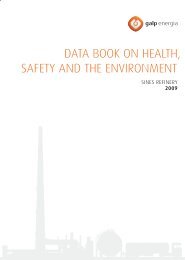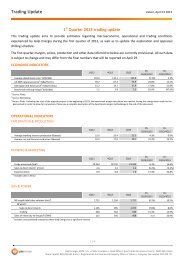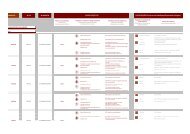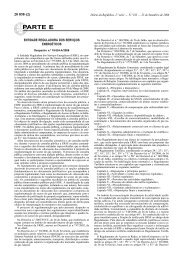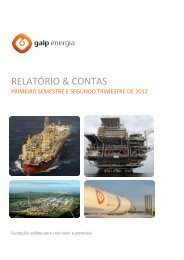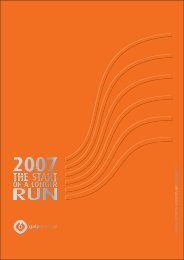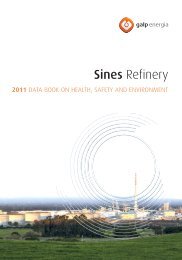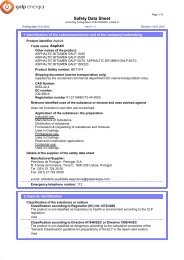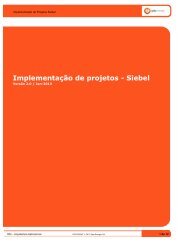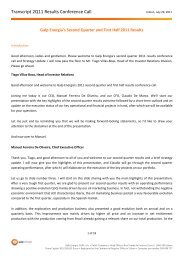2011 Matosinhos Data Book - Galp Energia
2011 Matosinhos Data Book - Galp Energia
2011 Matosinhos Data Book - Galp Energia
Create successful ePaper yourself
Turn your PDF publications into a flip-book with our unique Google optimized e-Paper software.
01<br />
02<br />
03<br />
Monitoring air quality<br />
<strong>Matosinhos</strong> refi nery focuses heavily on minimizing the<br />
environmental impact of its business, and these efforts are<br />
shown in the development of its key indicators and the high<br />
level of investment to improve the industrial plant.<br />
In this guideline, between March 2010 and December <strong>2011</strong> a<br />
comprehensive study to assess the air quality surrounding the<br />
refi nery was carried out. This study emerges from the concern<br />
that was expressed by the Commission for Coordination<br />
04<br />
Toluene is an aromatic hydrocarbon insoluble in water with a<br />
typical odor of paint solvent. Chemically, it is a mono-substituted<br />
benzene derivative i.e. that presents one of the hydrogen<br />
atoms of the benzene ring replaced by CH 3 group. Toluene<br />
occurs naturally as a component of various petroleum products,<br />
being widely used as industrial raw material and as a solvent<br />
for paints, coatings, glues, oil and resins.<br />
The term xylene refers to a set of three isomers closely related<br />
with benzene (Ortho-, meta-, and para-xylene). Xylene is a<br />
colorless aromatic hydrocarbon, with sweet odor and highly<br />
fl ammable. The Ortho-xylene (o-xylene) is the only form of<br />
naturally occurring xylene; the other two are forms of human<br />
manufacture. The XYLENES are used in gasoline and as a<br />
solvent in printing industries, rubber and leather. P-xylene is<br />
Sources of benzene emissions<br />
82%<br />
Automobile<br />
exhaust<br />
In “Scientific American Magazine, February 1998”<br />
14%<br />
Industry<br />
3%<br />
Individual<br />
activities<br />
0.1%<br />
Cigarettes<br />
Another study, “Position Paper” drawn up in September 1998<br />
by the “Council Directive on Ambient Air Quality Assessment<br />
and Management Working Group Benzene”, calculates,<br />
quoting “Air Quality Report of the Auto Oil Programme”, that<br />
the anthropogenic origin of benzene is due to the following<br />
sources.<br />
IN FOCUS 06 07 08 09 10 11<br />
of Development of the North (CCDR-N) to the extent that<br />
indicative studies carried out by that entity, indicated<br />
concentrations of benzene allegedly above the legal limits.<br />
The parameters considered in this program for monitoring<br />
air quality were the compounds SO 2 (sulfur dioxide), NO x<br />
(nitrogen oxides) and BTX. Under the designation BTX is the<br />
group of benzene, toluene and xylene compounds, being<br />
natural chemicals that are found in petroleum products such as<br />
gasoline.<br />
a raw material used in the manufacture of polyethylene (PET),<br />
polyesters and polymers.<br />
Benzene is a colorless and highly fl ammable aromatic<br />
hydrocarbon, slightly soluble in water, with a sweet smell and<br />
a relatively high melting point. Being a known carcinogenic,<br />
its use as a component of gasoline is currently limited to 1%,<br />
although an important industrial solvent and precursor in the<br />
production of synthetic rubber, nylon, plastics, insecticides,<br />
paints, dyes, glues, gum, detergents and cosmetics.<br />
The existence of benzene in the atmosphere, with<br />
anthropogenic origin, has its main source, about 80%, in road<br />
traffi c as shown in this graph:<br />
Sources of benzene exposure<br />
45%<br />
Cigarettes<br />
In “Scientific American Magazine, February 1998”<br />
18%<br />
Automobile<br />
3%<br />
Industry<br />
34%<br />
Individual<br />
activities<br />
Source (%)<br />
Road traffi c 80 - 85<br />
Oil refi neries 0.3 - 1.5<br />
Fuel distribution 2.6 - 6<br />
Chemical industry 1.3 - 13<br />
Domestic heating (fi replaces) 3 - 7<br />
Solvent use 1 - 4<br />
MATOSINHOS REFINERY / DATA BOOK ON HEALTH, SAFETY AND ENVIRONMENT <strong>2011</strong><br />
25<br />
05



